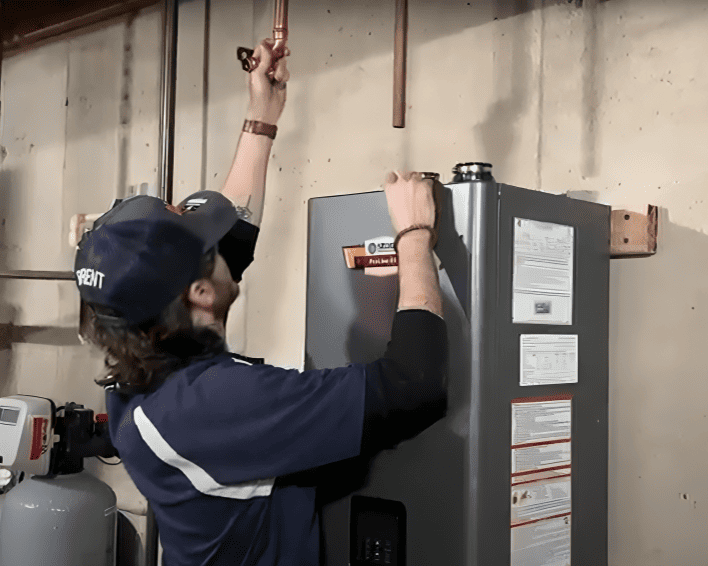
Quick Tip: Raise your water heater’s temperature by 5–10°F in winter. This helps keep hot water steady when cold groundwater affects performance.
Winter conditions in Dayton, Columbus, and Cincinnati, Ohio, can lower the temperature of incoming cold water by 10–15°F. This forces your water heater to work harder. As a result, it needs to heat water more efficiently. Logan Services plumbers are here to help you. We ensure you have enough hot water for every shower, dishwasher cycle, and laundry load. All water heaters use more energy in cold weather. This happens because pipes cool faster, demand increases, and freezing temperatures put stress on the home’s plumbing system.
To keep a steady supply of hot water, homeowners need proper settings and regular maintenance of their water heater. This is especially important during the colder months.
Need help preparing your water heater for winter? Call Logan Services at (800) 564-2611 for fast, friendly plumbing service.
Why Change Water Heater Settings in Winter?
Cold groundwater forces your water heater to create a larger temperature rise (the difference between natural and heated temperatures). When incoming water is 50–55°F, the system works harder to deliver hot water. Both tank and tankless units need to add more heat. A tankless heater adjusts instantly, while a tank model takes longer to reheat.
If a residential tankless water heater is too small, it may not provide enough hot water during winter. This can lead to a shortage of hot water at your faucets and fixtures. Electric models often struggle more in cold climates because they require more electricity to compensate for reduced incoming temperatures.
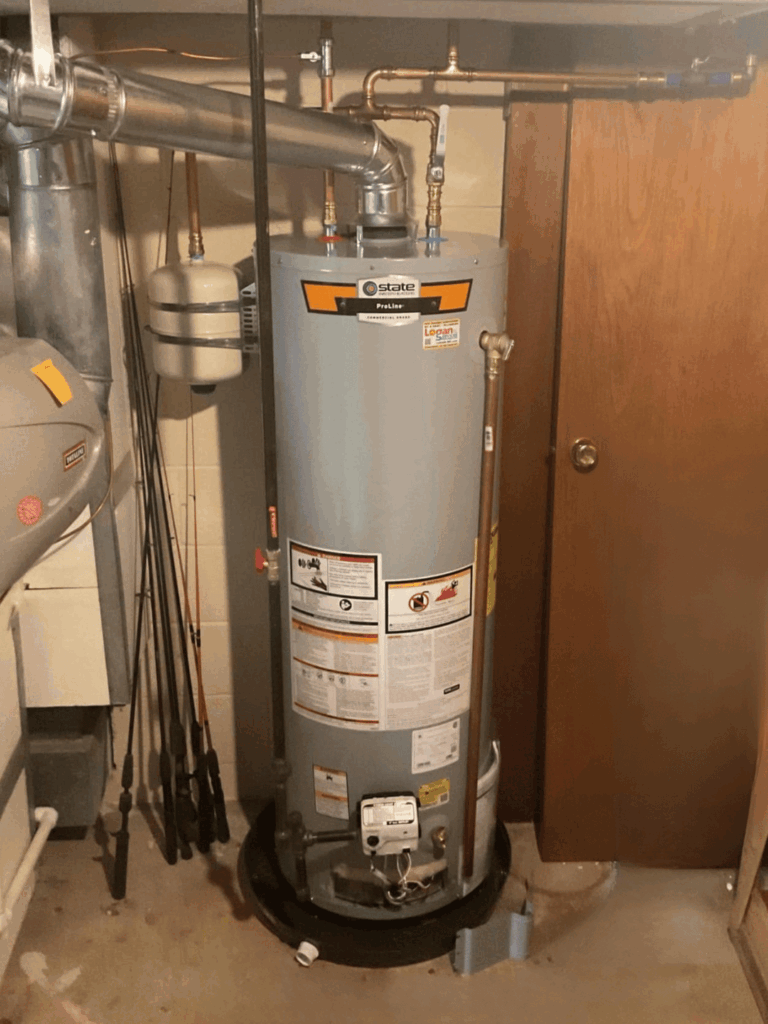
Optimal Settings for Natural Gas & Electric Tank Water Heaters
A standard tank water heater performs best in winter when set between 125–130°F. Electric heaters often require settings closer to 130°F in cold climates. This helps the heater deliver hot water consistently, even when cold water reduces the tank temperature quickly. Both gas heaters and electric heaters rely on this seasonal adjustment.
- Longer pipe runs require slightly higher settings.
- Anti-scald valves maintain safety.
- Testing the water temperature at the farthest faucet ensures the water heater provides hot water where needed.
How Much Should I Adjust My Water Heater in the Winter?
| Climate Zone | Summer Setting | Winter Setting | Homeowner Tips |
|---|---|---|---|
| Mild (Zones 1–3) | 120°F | 125°F | Minor winter adjustment |
| Moderate (Zones 4–6) | 120°F | 125–130°F | Ideal for much of Ohio |
| Cold (Zones 7–8) | 120°F | 130°F | Add insulation around tank and piping |
Optimal Settings for Electric Tankless Water Heaters
An electric tankless water heater heats water instantly. This makes it more sensitive to freezing temperatures and cold water entering the system. Many electric tankless water heaters must operate at 130–140°F to maintain a strong flow and adequate temperature.
- Gas tankless water heaters handle a large temperature rise more effectively.
- A tankless water heater must meet a minimum flow rate to activate.
- Cold weather may trigger an automatic shutoff if the tankless heater cannot provide hot water.
These adjustments help tankless units deliver endless hot water even during freezing temperatures.
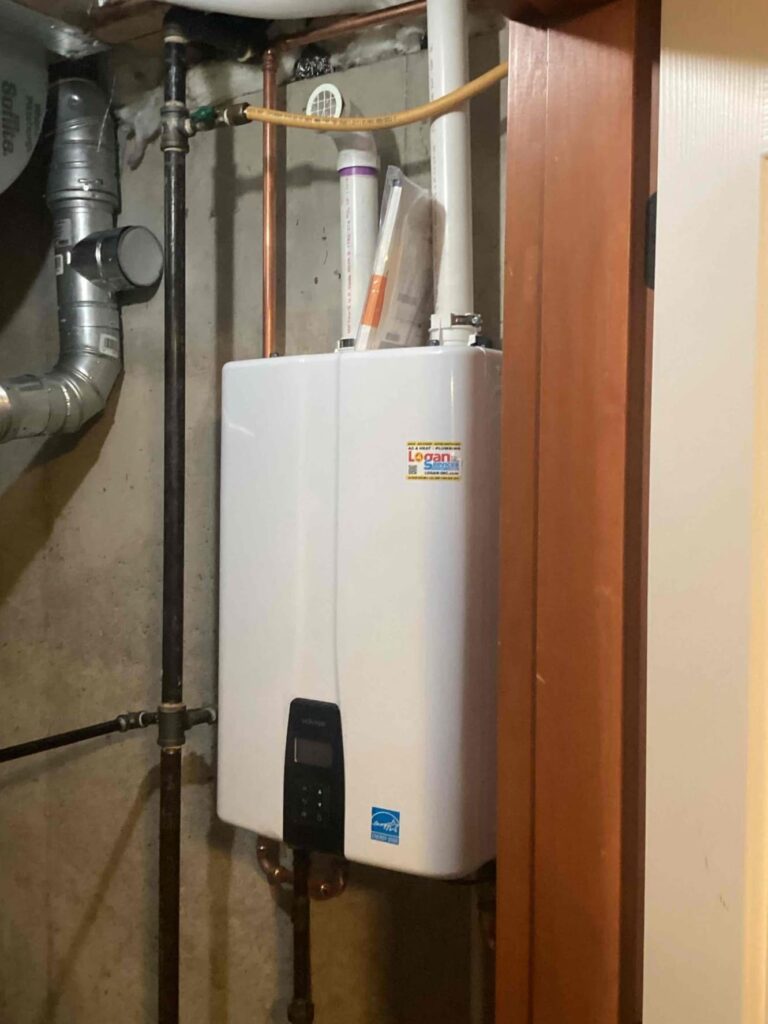
What is Temperature Rise?
Calculating temperature rise helps determine whether adjustments are necessary:
Desired Output – Incoming Water Temp = Temperature Rise Required
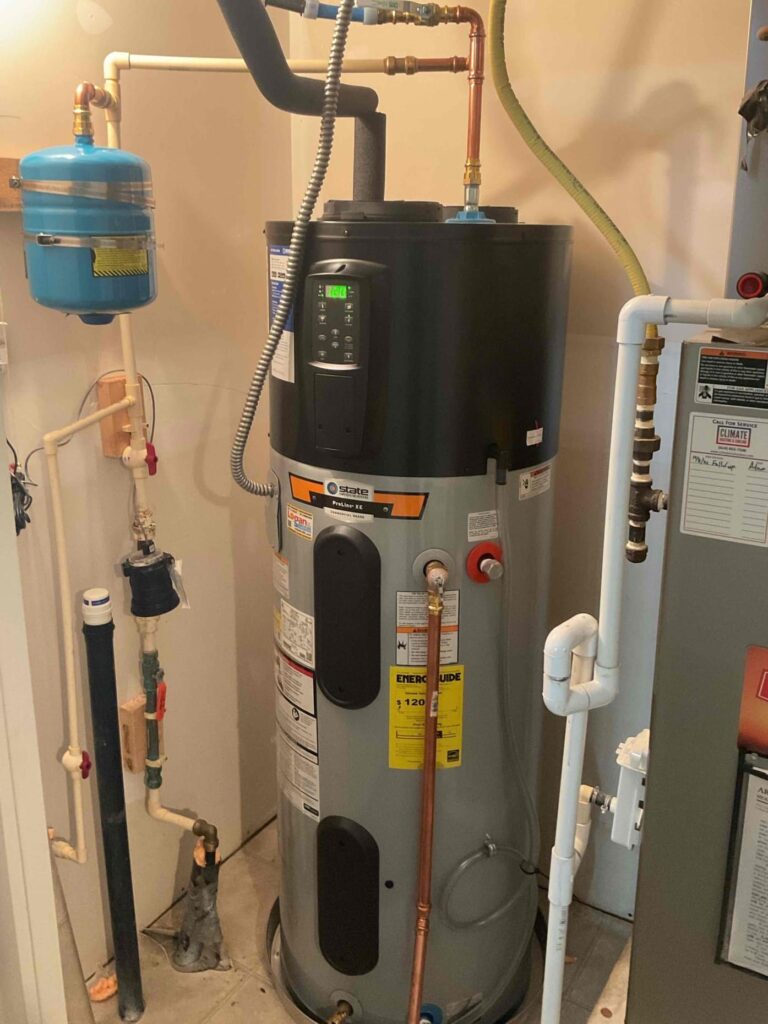
Optimal Settings for Heat Pump Water Heaters
A heat pump water heater pulls heat from the surrounding air to provide hot water. In cold climates, this unit may run longer because basements and garages drop below ideal temperatures.
Recommended setting: 120–130°F.
- Use Hybrid Mode for faster recovery.
- Ensure room temperatures remain above manufacturer minimums.
This improves energy-efficient operation and reliable output during winter.
Cost Efficiency by Fuel Type in Cold Climates
The table below compares performance by fuel type, considering energy use, installation costs, and winter operation.
The table below compares performance by fuel type, considering energy use, installation costs, and winter operation.
| Fuel Type | Winter Efficiency | Operating Cost | Advantages | Considerations |
|---|---|---|---|---|
| Electric Tank Water Heater | Moderate | Higher due to extended heating cycles | Low initial cost; easy installation | Slow recovery in cold weather; increased energy use |
| Electric Tankless Water Heater | Lower in cold months | Moderate to high | Endless hot water with proper sizing | Reduced flow rate in freezing temps; high electrical demand |
| Natural Gas (Tank) Water Heater | High | Lower than electric | Fast recovery; strong winter output | Requires safe venting and reliable gas supply |
| Natural Gas Tankless Water Heater | Very high | Often lowest overall | Efficient; handles large temp swings well | Higher upfront cost; annual maintenance needed |
| Heat Pump Water Heater (Hybrid) | Moderate in cold spaces | Lowest annual cost | Excellent long-term efficiency | Needs warm ambient air; higher initial cost |
A gas tankless system handles cold weather better, while an electric tank often uses more energy. A heat exchanger inside gas models boosts performance, especially in gas tankless water heaters with a secondary heat exchanger.
Improving Efficiency During Cold Weather
Improving the performance of your water heater ensures your home continues to provide hot water without wasting energy.
Key Winter Efficiency Measures
- Pipe insulation reduces heat loss and protects pipes from freezing.
- Recirculating pumps keep hot water moving to reduce wait times.
- High-efficiency gas models and heat pump systems help homeowners use less energy.
- Tank insulation jackets improve older tank performance.
Most winter efficiency improvements pay for themselves within one to two years through reduced utility costs.
Improving Efficiency During Cold Weather
Improving the performance of your water heater ensures your home continues to provide hot water without wasting energy.
- Insulate pipes to reduce heat loss.
- Use recirculating systems for faster hot water delivery.
- Maintain proper installation of every water heater type.
- Upgrade older traditional water heaters to more energy-efficient systems.
Most winter efficiency improvements pay for themselves within one to two years through reduced utility costs.
Safety Considerations in Freezing Temperatures
Safety becomes more important when your water heater works harder.
- Install anti-scald valves.
- Check thermostat accuracy.
- Maintain ventilation for gas models.
- Ensure the storage tank and pipes are protected from freezing.
Every water heater—whether tankless, tank-based, gas, or electric—needs attention during freezing temperatures.
Troubleshooting Common Winter Water Heater Issues
Cold weather exposes issues in any water heater system. If the water from your fixtures changes, it may be a sign of a problem. A sudden drop in flow rate can happen for several reasons. It could be due to freezing temperatures, hard water buildup, or electrical issues. The plumbers at Logan Services are here to troubleshoot and provide water heater repairs for all these common issues.
Frequent Winter Issues and Solutions
Lukewarm Water
- Improve insulation around pipes
- Verify tank or tankless heater thermostat settings
- Check mixing valve
- Consider a recirculation pump
Not Enough Hot Water
- Increase temperature 5–10°F
- Stagger shower usage
- Upgrade tank size if demand grows beyond supply
- Use low-flow fixtures to conserve energy
Short Cycling
- Flush sediment from tank heaters and heat exchangers
- Ensure proper airflow for tankless units
- Test thermostats for accuracy
Strange Noises
- Rumbling signals sediment buildup
- Crackling points to scale on heating elements
- Persistent noise requires professional inspection
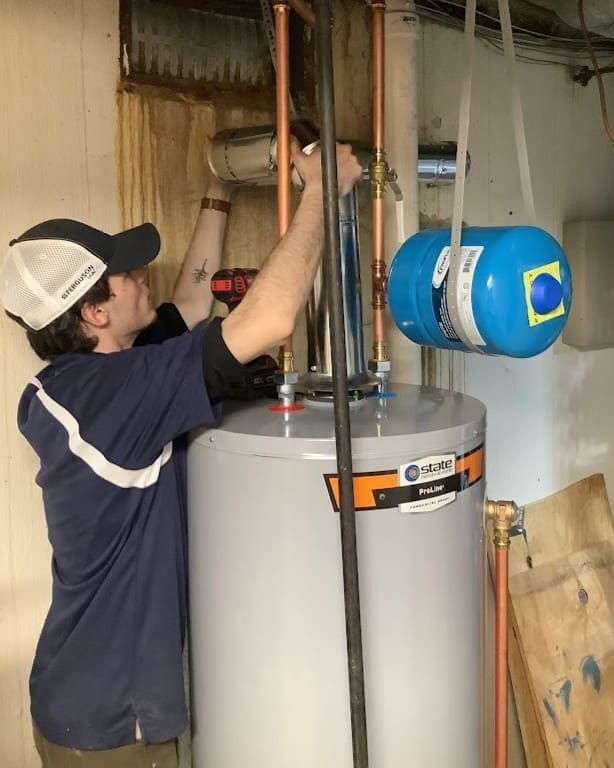
Professional Winter Maintenance and Preparation
Annual water heater maintenance with Logan Services ensures your plumbing system remains energy efficient and reliable during Ohio winters.
Core Winter Preparation Items
- Test thermostats, heating elements, and safety devices
- Inspect combustion for gas heaters
- Check insulation around pipes and the storage tank
- Verify proper gas line pressure for gas tankless and gas models
- Examine electrical components for electric heaters
- Review venting to prevent blockages
Heat pump systems, tankless water heaters, and traditional water heaters all benefit from professional maintenance before cold weather arrives.
Keep Hot Water Reliable All Winter
Adjusting your water heater for winter improves comfort, protects the unit, and ensures a dependable supply of hot water. No matter what type of water heater you have, it is important to prepare for winter. This includes tankless water heaters, tank water heaters, gas heaters, and electric heaters. Proper preparation helps your home provide hot water, even during the harshest winter weather.
For dependable hot water all winter long, call Logan Services at (800) 564-2611. Your comfort is our priority—let’s make sure your water heater is ready for the colder months.
Winter Water Heater FAQs
Most homes perform best between 125–130°F for tank models and 130–140°F for tankless units, depending on demand and groundwater temperature.
Cold groundwater requires the water heater to work harder, and heat loss through pipes increases, reducing available hot water. The plumbers at Logan Services provide winter preparation services. This helps keep your home’s plumbing system running smoothly all winter.
Yes, but use mixing valves or anti-scald devices when settings exceed 125°F. Our licensed and insured plumbers at Logan Services can install these devices and adjust your water heater’s temperatures accordingly.
Electric tankless models can lose flow rate during freezing temperatures, while gas tankless units typically perform better. Our plumbers will go over which model is best for your home’s water heater installation.
To prevent winter problems, insulate your pipes and use recirculating pumps. Make sure everything is installed correctly. Schedule annual maintenance with Logan Services’ plumbing team for the best results.

